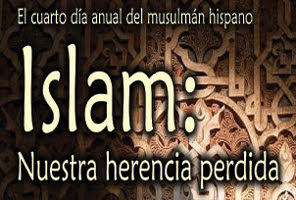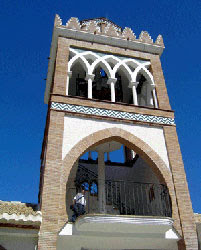http://mymasjid.org/content/view/46/2 The Islamic Educational Center of North Hudson held it’s 4th Annual Hispanic Muslim Day event yesterday (September 10th, 2006) to celebrate the Islamic heritage Latinos from across the globe share through their Moorish ancestors who once ruled Spain for over 800 years. The day’s event was filled with lectures, food, games, and Q&A sessions. Many Latino converts, along with some of their family and friends, attended the event that was first created by IEC 4 years ago to recognize their ever-growing Latino congregation. With the rapid rate by which Latinos are converting to Islam, IEC recognized the need for
Read MoreBy Mariely Torres I was born Mariely but now I am Maryam. I am very happy that I found Islam. It was very hard at first to find a person who could help me with this. There are not that many Muslims in Puerto Rico. I came upon Islam in New York when I saw a documentary. I heard the adhaan or call to prayer and I was very curious to know what that was. It brought an inner peace to me and I just had to know about Islam. I saw people conducting their prayers and it seemed so
Read MorePor Council on American-Islamic Relations de Canadá. (CAIR-CAN) http://www.caircan.ca En el Nombre de Dios, el Más Compasivo, el Más Misericordioso As-salámu aleikum. La paz esté sobre usted. Los materiales de publicidad siguientes se pueden modificar y utilizar por las comunidades locales para publicar el Hayy. Si modifica noticias sobre el Hayy, incluya referencias a actividades locales del Hayy y entre información de contacto para representantes local. Envíe esta información al “redactor de ciudad” de los periodicos locales, a los “redactores de asignación” de televisión y a los “directores de noticias” en la estaciones de la radio. Llamada justamente a cada
Read MorePor Shafiq (Juan) Alvarado Breve historia del español La lengua española tiene una historia fascinadora. Se desarrolló en la península ibérica y ahora es hablado por 332 millones de personas en cerca de 20 países y dentro de muchos otros países. Porque tanta gente en muchos países lo habla, el español fue elegido como uno de los idiomas representativos de las Naciones Unidas. Otro resultado es que una variación natural se ha desarrollado en todos los países y regiones. Por ejemplo, las palabras, el argot, y los dialectos españoles pueden variar dentro de un país o de una región particular.
Read MorePor Dr. Abdus Samad Romero Román La presencia actual de una imponente masa de inmigrantes y estudiantes musulmanes en Europa y Estados Unidos; obliga inevitablemente a los ciudadanos europeos y americanos a medirse con otra civilización y, sobre todo, con otra religión, El Islam. Civilización y religión que hoy, por fin; es necesario conocer, puesto que sólo a través de un reciproco conocimiento y comprensión será posible alcanzar una convivencia pacífica que permita una colaboración provechosa en el interés general. Se hace necesario, a la luz de cuanto sucede hoy (pero también en relación a lo que algunos personajes relevantes
Read MoreBy Khadijah Rivera http://piedad-latinodawah.blogspot.com/2007/06/islam-spreading-rapidly-among-latinos.html Islam Spreading Rapidly Among the Latino in the US and Latin America. First Latino Muslims Speaking Tour in Florida was organized with Imam Ali Siddiqui who delivered an impressive Khutbah at Tampa, Fl. OUR first Latino Speaking tour took off with many unexpected difficulties but many beautiful Muslims from Florida and California helped us to pull it off. We also learned valuable lessons from our shortcomings. First, a BIG KUDOS goes to Imam Ali Siddiqui, Imam Benjamin Perez and Br Mario Nunez. It’s just impossible to state how grateful we are! These wonderful brothers left deep
Read MoreBy Mahasin Shamsid-Deen Masjid Jauharatul-Islam, (The Jewel of Islam), the first mosque built totally along Islam design by indigenous American Muslims commemorates its 25th year on June 19, 2006. Activities to celebrate the anniversary will take place on Sunday, June 18, 2006. On Friday, June 19, 1981 the dedication for the new mosque was held at its location at 102 W. South Mountain Avenue in Phoenix, Arizona. Delegations from all over the United States and from Saudi Arabia, Jordan, Canada, Morocco, China, Malaysia, Pakistan, Nigeria, Turkey, Fiji Islands and Iraq attended the dedication ceremonies. Masjid Jauharatul-Islam started as the Phoenix
Read MorePor Mahasin Shamsid-Deen La Mezquita Yauharatul-Islam, (la Joya del Islam), la primera mezquita norteamericana construida totalmente en el diseño islámico por musulmanes americanos conmemora su 25to año este 19 de junio del 2006. Actividades para celebrar el aniversario ocurrirán el domingo, 18 de junio del 2006. En el viernes, 19 de junio del 1981, el esmero para la mezquita nueva fue llevado a cabo en su localización en la 102 Avenida de W. South Mountain en Phoenix, Arizona. Delegaciones de alrededor de los Estados Unidos y de Arabia Saudita, de Jordania, de Canadá, de Marruecos, de China, de Malasia, de
Read MoreBy Juan Galvan On Saturday, November 18, I had a unique opportunity to meet with Muslims from New York City and New Jersey. I met with Muslims at the 96th St Mosque until noon then with more Muslims at the Islamic Educational Center of North Hudson (IECNH) until 4:00PM. My visit to New York was mainly vacation but I wanted to meet some Muslims who I admire for their contribution. I have been blessed to meet many amazing Muslims on the Internet. I also wanted to request some input on a number of issues from them. Originally, my plan was
Read MoreBy Nichola Saminather November 18, 2005 When Pamela “” now Aisha “” Munoz came to the United States from Bolivia five years ago in search of her true self, she didn’t imagine that it would involve a radical conversion away from her Roman Catholic roots. Today, 17 months after she accepted Islam, she sits serenely on a metal bench in the bustling Queens Center Mall in Elmhurst, with her black hijab wrapped securely around her head. She has, she says, finally found what she was seeking. Without the hijab “” the Muslim headscarf — she could be any 23-year-old Latina.
Read More“Invite (all) to the Way of thy Lord with wisdom and beautiful preaching; and argue with them in ways that are best and most gracious: for thy Lord knows best, who has strayed from His Path, and who receives guidance.” – Qur’an 16:125. “And the word of thy Lord has been fulfilled in truth and justice. None can change His words, and He is the All-Hearing, the All-Knowing.” – Quran 6:116. The Prophet would say for those who were ill, “O Lord of the people! Remove the difficulty and bring about healing as You are the Healer. There is no
Read More

